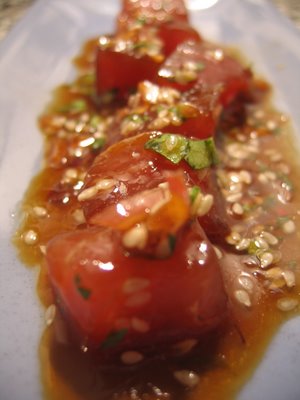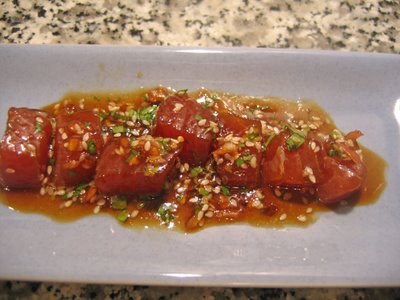 Ahi Poke is available all over Hawaii in restaurants and sushi bars and is even sold, pre-made, in supermarkets.
Ahi Poke is available all over Hawaii in restaurants and sushi bars and is even sold, pre-made, in supermarkets.
I first tried ahi poke on a visit to Hawaii in 2004 and was pleasantly surprised by the modern take on traditional Japanese sashimi, as well as the successful addition of coriander and the sweet nutty sesame seeds.
This recipe is quick and easy so all you'll need is fresh tuna and a healthy appetite.
Ahi Poke
Recipe from Williams-Sonoma cookbook “Savouring America”. Serves 6.
Ingredients:
500g sashimi-grade tuna steaks, skin & bones removed
½ cup finely chopped sweet onion
3 tablespoons soy sauce
2 tablespoons finely chopped fresh coriander
2 teaspoons sesame seeds, toasted
Few dashes of sesame oil
Large pinch of coarse sea salt
Pinch of red chilli flakes
Coriander leaves for garnish
Method:
1. Using a sharp knife, cut the tuna into small 2cm by 2cm cubes.
2. Place tuna in a bowl and add all other ingredients.
3. Toss the mixture gently to blend evenly. Cover the bowl and refrigerate until well chilled, about 1 hour.
4. Serve garnished with coriander leaves.
Notes: Ahi poke is best eaten within a few hours of being made, but can be kept in the refrigerator for one day. Hawaiians use Maui onion, but for those of us outside the US, any sweet onion will substitute. Yellow-fin tuna is best for this recipe, although any other sashimi-grade is fine.
" Open Sesame"
Sesame is a plant widely cultivated for its deliciously nutritious seeds which contain high levels of copper, manganese, tryptophan, calcium magnesium, iron, phosphorous, zinc, vitamin B1, and dietary fibre.
In countries without oil groves, sesame oil is an important cooking oil. In fact sesame seeds are extremely rich in oil - an estimated 50% of the seed.
The origin of sesame is unknown, but studies show its closest cousins growing in Africa. The first records of cultivation come from 2000 BCE in Assyria and Babylon (modern day Iraq and Syria). It later spread throughout the Middle East and Asia.
The etymological root of the English word sesame shows its path through world cuisines. The Latin sesamum came from the Greek sēsámon which had fashioned itself after the Aramaic shūmshĕmā. This was a derivative of Babylonian shawash-shammu via Assyrian shamash-shammū. What amazes me more than anything is how close the English word remains to the original Assyrian source despite geographical distance and thousands of years.
Around 4000 years ago in China, records show sesame seed was burnt to create soot for making ink. In Ancient Greece, soldiers carried sesame seeds as emergency rations and in India, sesame is a good luck omen for Brahmins who use it as anointing oil.
It is said that The Arabian Night’s tale used “open sesame” as the magic access to the thieves den because the sound of a sesame seed being released from its pod is similar to a lock opening.
In the Middle East sesame seeds are used to make a nut paste (tahini) and a dessert (helva). In Syria and Lebanon it’s an important ingredient in a spice dip (zatar) and sesame seeds crown Turkey’s favourite snack food (simit). In Greece sesame seeds are set into slices sweetened with honey (pasteli) and they are also widely used in Indian, Korean and Japanese cuisine as a garnish and flavouring. In Europe, seeds are sprinkled over cakes and breads as decoration.
References:
http://en.wikipedia.org/wiki/Sesame
http://www.whfoods.com/genpage.php?tname=foodspice&dbid=84
http://www.theepicentre.com/Spices/sesame.html
http://www.jeffersoninstitute.org/pubs/sesame.shtml
http://www.apinchof.com/sesame1015.html
Tags: morsels and musings food blog food and drink australia recipes appetiser snack sashimi seafood fish tuna maguro ahi ahi poke hawaii japan japanese food hawaiian food japanese recipe hawaiian recipe coriander cilantro soy sauce onion maui onion sweet onionsesame seeds sesame sesame oil

This loos so delicious. Just the type of dish I love. I cannot wait to try it! Thank you!
ReplyDeleteBeautiful...that looks like something I would order in a restaurant!
ReplyDeleteAha! You can bet your delicious poke photo that I'm going to be eating LOTS of this dish when I get back home next month!
ReplyDeleteI love poke and your poke looks really good. Nice pictures, too.
ReplyDeleteraw fish seems so yucky but you make it sound (and look) so good!! lolz!!
ReplyDeleteLove Poke, first had it when a Hawaiian friend made it for a pot luck, the one I had had lots of red onion and spring onion in it but think the corriander is what I'd personally prefer - will try out this recipe seeing friend is now back in Hawaii :) Photos look lovely and fresh.
ReplyDeletethanks kat!
ReplyDelete